Magna Britannia: Volume 4, Cumberland. Originally published by T Cadell and W Davies, London, 1816.
This free content was digitised by double rekeying. Public Domain.
Daniel Lysons, Samuel Lysons, 'General history: Gentry', in Magna Britannia: Volume 4, Cumberland(London, 1816), British History Online https://prod.british-history.ac.uk/magna-britannia/vol4/lxix-xcviii [accessed 23 April 2025].
Daniel Lysons, Samuel Lysons, 'General history: Gentry', in Magna Britannia: Volume 4, Cumberland(London, 1816), British History Online, accessed April 23, 2025, https://prod.british-history.ac.uk/magna-britannia/vol4/lxix-xcviii.
Daniel Lysons, Samuel Lysons. "General history: Gentry". Magna Britannia: Volume 4, Cumberland. (London, 1816), British History Online. Web. 23 April 2025. https://prod.british-history.ac.uk/magna-britannia/vol4/lxix-xcviii.
In this section
Gentry.
Barwis of Langrigg-hall. — This family was originally of Dearham, having married the heiress of Dearham at an early period. The heiress of the elder branch of Barwis, married Lamplugh. Another branch, settled at Ilekirk, in Westward, became extinct about the latter end of the seventeenth century. The coheiresses married Fetherstonhaugh, who died without issue, and Kirkby, who sold Ilekirk to Emerson. Thomas Barwis, Esq., who settled at Langrigg-hall, was grandfather to the Reverend John Barwis, the present proprietor, who resides on his rectory of Niton in the Isle of Wight. It is remarkable, that two ladies of this family have attained the age of 100 years; Mrs. Ann Barwis, buried at Dearham, in 1686; and the mother of the present Mr. Barwis, who died in 1814, at Langrigg-hall.

Arms of Barwis: — Arg. a chevron between three bears' heads, couped, Sable, muzzled, Or.
Beauly or Bewley of Hesket. — Some of this family were knights of the Shire, temp. Ric. II., &c. The elder branch became extinct in the reign of Charles I., when the heiress married Lawson. Mr. George Bewley of Woodhall, in Caldbeck, is descended from a younger branch. We have not been able to ascertain what arms were borne by the Bewleys of Hesket.
Blencowe, of Little-Blencow. — The first of this family whom we have been able to trace, lived in the reign of Edward III., and was the immediate ancestor of Henry Prescot Blencowe, Esq., (now residing at Bath) who sold Blencow in 1802 to the Duke of Norfolk.

The Arms borne of late years by the Blencowe family, (Azure, a bend, Arg. charged with three chaplets of roses, Gules; quartered with, Gules, a canton, Argent,) vary somewhat from those which were granted to their ancestor, Adam de Blencowe, in the reign of Edward III., by William, Baron of Greystock. (fn. n1)
Crest: — On a sword pointed downwards a human heart, pierced through, between two wings.
Brougham of Scales-hall. — The ancient family of Brougham, of Brougham, in Westmorland, were long possessed of property in this county, and for some generations, till Brougham, which had been sold to the Birds, was repurchased of that family, Scales-hall, in the parish of Skelton, was their usual residence. Henry Brougham, Esq., M.P. Barrister at Law, is the present representative of this family.

Arms:—Gules, a chevron Arg. between three fishes, (luces) hauriant, Proper.
Crest: — A sinister arm embowed, in armour, issuing out of a wreath, holding a fish.
Browne of Tallantire. — William Browne, Esq., of Orthwaite-hall, near Uldale, father of William Browne, Esq., now of Tallantire, purchased, and settled at this place, in the year 1776.

Arms: — Arg. three martlets in pale Sab. between two flaunches of the second, each charged with a lion passant of the first.
Crest: — A Griffin's head.
Christian of Unerigg-hall. — The Christians are descended from the ancient family of M'Christen, of the Isle of Man, who, for several generations, were Deemsters or Judges of that island. They appear to have first written their name Christian about the year 1600. Ewan Christian, Esq., the first of the family who settled at Unerigg, died in 1719. Unerigghall is now the seat of John Christian, Esq., only son (by the first marriage) of John Christian, Esq., who, in consequence of his subsequent marriage with the heiress of Curwen, took the name of that family in addition to his own.

Arms of Christian: — Azure, a chevron humetté between three covered cups, Or.
Crest: — An unicorn's head erased, Arg. collared and armed, Or.
Crackenthorp of Bank-hall in Kirkland. — This is an ancient Westmorland family, branches of which have occasionally been settled in Cumberland. Crackenthorp of Cockermouth was sheriff of this county, temp. Hen. VI. Some time after the death of James Crackenthorp, Esq. of Newbiggin in Westmorland, (who was proprietor also of Bank-hall, although the family had not resided there for several generations) his nephew Christopher Crackenthorp Cookson, Esq., of Penrith, took the name of Crackenthorp, and was father of William Crackenthorp, Esq., the present representative of the family.

Arms of Crackenthorp: — Or, a chevron between three mullets, pierced, Sable.
Denton, of Denton, Warnell, and Cardew. — This ancient family was of Denton-hall, in Nether-Denton, soon after the conquest. The male line became extinct, in the elder branch, after five descents, by the death of Sir Richard Denton, whose heiress married Adam Copley; Richard Copley, grandson of Adam, had a daughter and heiress married to Adam del'Hall, who took the name of Denton, and had a grant from his fatherin-law of the arms of Denton, as borne by his maternal ancestor, Sir Richard Denton (fn. n2). This Adam was ancestor of the Dentons of Warnellhall, who began to reside at that place (which they acquired in exchange for Denton) as early as the middle of the sixteenth century; the immediate male descendant of this branch is Mr. Charles Denton, of Cockermouth, nephew of John Denton, Esq., who sold Warnell-hall to Sir James Lowther, (afterwards Earl of Lonsdale) in 1774.

Arms of Denton of Denton and Warnell-hall, as granted by Richard Copley, and still borne by the family. — Arg. two bars, Gules, in chief three cinquefoils, Sable.
The Dentons of Cardew were descended from a younger branch of the original male line of Denton, of Denton, who settled at Ainstable as early as the reign of Edward II., and afterwards removed to Cardew: we can trace nothing of this branch after George Denton, who sold Cardew to Sir John Lowther, in 1686.
Arms of Denton of Cardew: — Arg. 2 bars, Gules, in chief three martlets of the second.

Crest: — A martlet, Sable, as described in the heralds' visitations; but it is said in the MS. of John Denton, of Cardew, that they bore for their crest, a castle burning, with a flaming sword in a lion's paw on the top of it, granted by Edward Baliol to their ancestor, for his gallantry in defending a castle in Annandale, against Robert Bruce.
Dykes of Dovenby. — This family were originally of Dykesfield, in Burgh, where they are traced three generations before 50 Edward III. Thomas Dykes, who died in 1658, is the first described in the pedigree as of Warthole, which was for some generations, the seat of the family, and is now the property of Joseph Dykes Ballantine Dykes, Esq., of Dovenby. This gentleman being the elder son of Lawson Dykes, Esq., of Crookdakehall, who took the name of Ballantine in 1773, married his first cousin, the daughter and heiress of the late Frescheville Dykes, Esq., of Warthole. The heiresses of Waverton, of Waverton in Cumberland, Distington, Pennington, Radcliffe of Cockerton, in Durham, and De la Vale, and a coheiress of Salkeld, have married into this family.

Arms: — Or, three cinquefoils, Sable.
Crest: — A lobster, vert.
Fetherstonhaugh, of Kirk-Oswald. — Henry Fetherstonhaugh, a younger son of the family of that name in Northumberland, settled at Kirk-Oswald. Timothy Fetherstonhaugh, Esq. now of this place, is the son of the Reverend Charles Smallwood, who married the sister of Timothy Fetherstonhaugh, Esq., by whose death, in 1797, the male line of this branch became extinct.

Arms: — Gules, a chevron between three ostrich feathers, Argent.
Crest: — An antelope's head, Gules, crined and armed, Or, charged on the neck with an ostrich's feather and an annulet, Argent.
Gibson, of Barfield. — A younger branch of the Gibsons of Gunmorepark, and Myerscough-house, in Lancashire, settled in Cumberland about the middle of the seventeenth century. The present representative of this branch is Robert Gibson, Esq., whose eldest son, now of Gray's-Inn, has lately taken the name of Atherley, in addition to that of his own family.

Arms of Gibson: — Azure, three storks rising, Proper.
This family bears two crests: — A stork rising, Proper, in his beak an olive branch, vert; and a lion rampant grasping a club.
Gilpin of Scaleby, originally of West-ward. — One of the ancestors of this family was slain at Bosworth field. The present representative of the Gilpins of Scaleby (who left Cumberland after the sale of that estate) is William Gilpin, Esq., of East-Sheen, in Surrey.

Arms: — Or, a boar passant, Sable.
Crest: — A pine branch, Vert.
Halton of Greenthwaite-hall, in Greystock, from the time of Ric. II., removed early in the last century to SouthWinfield manor-house, in Derbyshire, which is now the residence of Winfield Halton, Esq. the representative of this family.

Arms: — Party per pale, Gules and Azure, a lion rampant, Or.
Hasell of Dalemain. — Sir Edward Hasell, Knight, ancestor of Edward Hasell, Esq., the present possessor settled at Dalemain, in the reign of Charles II.

Arms: — Or, on a fesse Az., between three hazel slips Proper, three crescents Argent.
Crest: — A squirrel, seiant, cracking a nut, between two oak branches, all Proper.
Highmore of Harby-brow. — A branch, it is probable, of the Highmores of Armathwaite, in Bassenthwaite, married the heiress of Boyvill, and settled at Harby-brow, in the reign of Edward IV. Francis Highmore, Esq., who sold this estate, died without issue in 1610; his sister and heiress married Francis Troughton. A younger son of Alexander Highmore (of this family) who died in 1593, settled in Dorsetshire. The representative of this branch is W. R. Highmore, Esq., of Wanstrow, near Frome in Somersetshire.

Arms: — Argent, a cross bow pointed upwards, between four moor-cocks Sab. membered and beaked, Gules.
Crest as granted in 1683: — Out of a wreath, Arg. and Sab. an arm armed Proper, brandishing a faulchion, Arg. hilt and pomel, Or, between two leading pikes, Gules, headed, Or.
Howard of Corby. — Sir Francis Howard, second son of Lord William Howard, and grandson of Thomas Duke of Norfolk, settled at Corby, which he possessed by gift of his father, and was the immediate ancestor of Henry Howard, Esq. now of Corby.
Arms: — The same as the Duke of Norfolk, with due difference.
Hudleston of Hutton John. — An ancestor of this ancient family being originally of Hudleston, in Yorkshire, married the heiress of Millom of Millom, in the reign of Henry III. The elder branch continued to reside at Millom, (where a castle was built by Sir John Hudleston, in the reign of Edward III.) for many generations. William Hudleston, the last of the Millom branch, died in 1745; his daughter and heir married Sir Hedworth Williamson, Bart. The coheiresses of Fenwick and Stapleton have married into this family. Andrew, a younger son of John Hudleston, who lived in the reign of Henry VIII., married the heiress of Hutton, of Hutton-John, in the parish of Greystock; and was the immediate ancestor of Andrew Hudleston, Esq. now of Hutton-John.

Arms: — Gules, a fret, Argent.
Crest: — Two arms, dexter and sinister, embowed, vested, Arg. holding in their hands, a scalp Proper, the inside Gules.
The Hudlestons of Sawston in Cambridgeshire, now represented by Francis Hudleston, Esq., are descended from a younger branch of this family, which, in consequence of a marriage with one of the coheiresses of the Marquis Montague, settled at Sawston, in the reign of Henry VIII.
Irton of Irton. — This ancient family are traced as resident at Irton, whence they took their name, as early as the reign of Henry I. The present representative is Edmund Lamplugh Irton, Esq., of Irton-hall. An heiress of Copeland, and a coheiress of Bassenthwaite, married into this family.

Arms: — Arg. a fesse Sab. in chief, three mullets, Gules.
Crest: — A demi-lion Sab. collar'd Arg. holding in his dexter paw a mullet, Gules.
Johnson of Walton-house. — John Johnson, Esq., father of William Johnson, Esq. now of Walton-house, purchased this estate, and settled there in 1789.

Arms: — Arg. on a saltier Sab. five besants; on a chief Gules an eastern crown between two woolpacks, Or,
Crest: — An estoile within a spur erect, between two wings elevated, Or.
Leathes of Dale-head. — This ancient family were of Leathes in the parish of Aikton, soon after the conquest. Thomas Leathes, Esq., the last heir male died in 1806; his nephew, Thomas Stanger, Esq., shortly afterwards took the name of Leathes in addition to his own, pursuant to his uncle's will. Mr. Stanger Leathes resides at Dale-head during the summer season.
Arms of Leathes: — Azure, on a bend between three fleurs de lis Argent, as many mullets, Gules.

Crest: — A lion's head affronté.
Lutwidge of Holme-Rook. — The present representative of this family is Major Skeffington Lutwidge, nephew of the late Admiral Lutwidge.

Arms — Azure, three morions, or steel caps, Or.
Crest: — A lion rampant.
Milbourne of Armathwaite castle. — William Milbourne, Esq. first possessed this estate by bequest from the Sandersons in 1741. Robert Sanderson Milbourne, Esq., the present representative of this family, is son of a cousin of the above-mentioned William.

Arms of Milbourne. — Sable, a chevron between three escallops, Argent.
Crest: — A griffin's head erased.
Patrickson of Stockhow, Caswell-how, and Calder-abbey. — The representative of this ancient family, whose property in this county has been long since alienated, is Hugh Patrickson, Esq. Paymaster of the Third regiment of Dragoons.

Arms: — Or, a fesse between three greyhounds, current, Sable.
Crest: — On a mount Vert, a stag current, Proper, hoofed and attired, Or,
Pattenson of Melmerby. — The ancestor of the Reverend Thomas Pattenson, now of Melmerby-hall (being of a Westmorland family) settled at this place about a century ago, in consequence of his marriage with the heiress of Threlkeld.

Arms: — Arg on a fesse Sab. three fleurs de lis, Or.
Crest: — Out of a ducal coronet, a camel's head issuant.
Ponsonby of Hale. — This family were originally of Ponsonby, where they are to be traced by the name of Ponsonby before the reign of Edward II. At an earlier period, the first of the family of whom we find any mention was called Ponson, his son Fitz-ponson. Miles Ponsonby, Esq., a lieutenant in the navy, is the immediate representative of this ancient family. Two younger brothers of the Ponsonbys of Hale, Sir John and Henry, went into Ireland about the middle of the seventeenth century. Sir John was ancestor of the noble families of Besborough and Ponsonby; Henry of the Ponsonbys of Crotto.

Arms: — Gules, a chevron between three combs, Argent.
Sandes or Sandys of St. Bees. — This family was originally of Burgh on Sands, being called in ancient evidences De Sabulonibus. One of the family was knight of the shire, temp. Ric. II. They had been settled at Rotington in St. Bees, for five descents, at the time of the visitation in 1615. The family has been long extinct in Cumberland; but some of the male descendants still remain; from William Sandys, a younger son of this family, who went into Lancashire, descended Archbishop Sandys, common ancestor of the late Lord Sandys of Ombersley, the baronets of Cambridgeshire and Kent, all extinct, Sir Edwin Bayntun Sandys, Bart, now of Miserden Park in Gloucestershire, and other branches.
The arms are not described in St. George's Visitation, 1615; it is uncertain, therefore, what coat was borne by the Cumberland family. The several branches above-mentioned have borne three moors' heads, and three cross crosslets variously combined, with one or with two chevrons, and of various colours.
Senhouse of Seascales and Nether-hall. — The ancestors of this family were originally of Seascales, where we find them somewhat prior to the reign of Edward III. The elder branch of the Seascales family became extinct by the death of John Senhouse Esq., who was living in 1688 (fn. n3). The late John Senhouse, Esq., of Calder-abbey, who left no male issue, was of a younger branch of the Seascales family.
John Senhouse, a younger son of John Senhouse of Seascales, who married one of the coheiresses of Eglesfield of Alneburgh-hall, (now Nether-hall,) settled at that place, and was the immediate ancestor of Humphrey Senhouse, Esq., now of Nether-hall. Coheiresses of Lucy and Eglesfield, married into the Senhouse family. After the separation of the branches, one of the Seascales family married a coheiress of Bimpson, who had married a coheiress of Writington.

Arms of Senhouse: — Or, a parrot, vert.
Crest: — A parrot, vert.
Stanley, formerly of Dalegarth, now of Ponsonby. — John, a younger son of John Stanley, Lord of Stanley and of Stourton in Cheshire, (which John was ancestor also of the Earls of Derby, and of the Stanleys of Cheshire, Baronets) settled at Greswithen in Cumberland, in the early part of the fourteenth century. Nicholas, his grandson, on marrying the heiress of Awsthwaite, removed to Dalegarth, where the family resided for several generations. The immediate descendant of this ancient family is Edward Stanley, Esq. of Ponsonby-hall, whose grand-father pulled down the old mansion at Dalegarth.

Arms: — Arg. on a bend. Az. cottised, Vert, three stags' heads caboshed, Or.
Crest: — A stag's head Argent, attired, Or, collared, Vert.
Warwick of Warwick. — This ancient family, now extinct in the male line, were descended from Odard, to whom the manor was given by Ranulph de Meschines in the reign of Henry I. Francis Warwick, Esq., the last heir male, died in 1772. Robert Bonner, Esq., then the only representative of the family in the female line, (through the Maddisons) took the name of Warwick in 1792, and is the present proprietor of the Warwick estate.
Arms of Warwick: — Azure, three lions rampant, Argent.

Crest: — A dexter arm couped at the shoulder, in armour, holding in the gauntlet, a battle-axe, all Proper.
Whelpdale of Skirsgill and Penrith.—This ancient family, of whom was Roger Whelpdale, made Bishop of Carlisle in 1419, have been settled for many generations at Skirsgill in Dacre, and at Penrith. The present representative of this family is William Whelpdale, Esq., now of Beck, in the parish of Ainstable. John Richardson, Esq., whose father married the heiress of Thomas Whelpdale (fn. n4), Esq., sometime of Bishop's Yard in Penrith, has taken the name of De Whelpdale, with the family arms, pursuant to the will of his maternal grandfather.

Arms: — Arg. three greyhounds current in pale, Gules, collared, Or.
Wybergh of St. Bees. — William Wybergh of this place married the heiress of Engayne of Clifton in Westmorland in the reign of Edward III. In the visitation of 1665, the family were described as of Clifton and St. Bees. Thomas Wybergh, Esq., the representative of this ancient family resides at present at. Brayton in Cumberland as guardian of his son Wilfred, as yet under age, who inherits the Lawson estates, under the will of the late Sir Wilfred Lawson Baronet, whose name he has taken.

Arms of Wybergh: — Or, three bars, Sable, and in chief, two mullets of the second.
Families extinct before 1500.
Allonby of Allonby. — One of the coheiresses married Flimby.
Allerby of Alwardby. — The heiress married into a younger branch of the Porters of Weary-hall.
Arcleby of Arcleby. — The heiress married Martindale.
Awsthwaite (fn. n5) of Awsthwaite. — Extinct temp. Edw. III. The heiress married Stanley.
Bassenthwaite of Bassenthwaite. — Extinct temp. Edw. II. One of the coheiresses married Irton, and afterwards Lawson; the other Martindale.
Beauchamp (fn. n6) of Little-Croglin. — Extinct about temp. Hen. VII.
Boyvill, alias Levington. — The elder branch extinct temp. Hen. III. The heiress married Baliol. A younger branch extinct temp. Edw. IV. The heiress married Highmore of Harby-brow.
Branthwaite (fn. n7) of Branthwaite. The heiress married Skelton.
Brayton of Brayton.
Broughton of Broughton. — Extinct temp. Hen. VI.
Brun of Drumburgh Castle. — Extinct temp. Ric. II. The coheiresses married Harington, Curwen, and Bowet.
Cardew of Cardew. — Extinct temp. Edw. I.
Castle-Carrock of Castle-Carrock. — Supposed to have been descended from Eustace de Vallibus. — Extinct temp. Edw. I. The coheiresses married Newbiggin, Appleby, and Eglesfield.
Colvill. — Who married the heiress of Tiliol; extinct temp. Edw. IV, The coheiresses married two brothers of the Musgrave family.
Copeland (fn. n8) of Bootle. — Extinct about temp. Ric. II. The coheiresses married Hudleston, Penington, and Senhouse.
Corby of Corby. — Extinct temp. Edw. I.
Corney of Corney. — Extinct temp. Hen. III. The heiress married Penington.
Dale of Dale-head. — The heiress married Leathes.
Deerham of Deerham. — The heiress married Barwis.
Derwentwater (fn. n9) of Derwentwater. — Extinct temp. Ric. II. The heiress married Radcliffe.
Dovenby of Dovenby. — Extinct temp. Hen. III.
Dundraw of Dundraw. — The coheiresses married Clapell, Tinmouth, and Crofton.
Farlam of Farlam. — Extinct temp. Edw. III.
Fenwick (fn. n10). — A branch of the Northumberland family of that name. One of the coheiresses married Hudleston.
Frisington of Frisington. — Extinct temp. Hen. IV. The coheiresses married Sackfield, Lawson, and Atkinson.
Gosforth of Gosforth. — Extinct early in the fourteenth century. The coheiresses married Caddy, Hustock, Garth, Kirkby, and Estholme.
Greenhow of Greenhow. — The heiress married Briscoe.
Grinsdale of Grinsdale. — The elder branch extinct temp. Joh. The coheiresses married Newton and De la Sore. A younger branch extinct temp. Edw. III.
Hale of Hale. — Extinct temp. Edw. I. The heiress married Ponsonby.
Hayton of Hayton. — The heiress married Mulcaster, a younger branch of the Penington family.
Hughthwaite of Hughthwaite. — The heiress married Swinburne.
Ireby (fn. n11) of Ireby. — One of the coheiresses of the elder branch married Estoteville, the other Lascelles, and afterwards Charters. A younger branch extinct temp. Ric. II.
Langrigg of Langrigg. — Extinct temp. Edw. I. The coheiresses married Osmunderley and Laithes.
Levington of Levington. — Extinct temp. Hen. III. The heiress married Baliol, who died without issue.
Millom of Millom (fn. n12) (a branch of the Boyvills). — Extinct temp. Hen. III. The heiress married Hudleston.
Moresby (fn. n13) of Moresby. — Extinct before 1500. The heiress married Pickering.
Morton of Morton.
Morvill (fn. n14) of Isel, Kirk-Oswald, &c. Extinct about temp. Joh: One of the coheiresses married Gernon; the other Lucy, and afterwards Multon.
Newton (fn. n15) of West-Newton. — The heiress married Martindale.
Orton (fn. n16) of Orton. — The heiress married Skelton.
Parton of Parton. — The heiress married Mansell.
Parvinge of Blackhall, &c.
Raughton of Raughton. Extinct temp. Edw. IV.
Redman (fn. n17) of Cockermouth.
Regny of Newton-Regny. — Extinct temp. Edw. I. Four coheiresses.
Rotington of Rotington.
Staffold of Staffold. — Extinct temp. Hen. V. The coheiresses married Chambers, Mulcaster, and Blenerhasset.
Stapleton (fn. n18) of Edenhall. — Extinct temp. Hen. VI. The two coheiresses married into the Musgrave family.
Stavely of Renwick. — Extinct temp. Edw. I.
Swinburn of Bewcastle. — Extinct temp. Edw. III. The heiress married Strivelin.
Tallantire of Tallantire.
Tiliol of Scaleby. — Extinct 14 Hen VI. The coheiresses married Colvill and Moresby.
Turp of Edenhall. — Extinct temp. Edw. III. One of the coheiresses marred Stapleton.
Vipont (fn. n19) of Aldstone-Moor. — The heiress married Stapleton.
Wigton of Wigton. — Extinct temp. Edw. III. The heiress married Gernon.
In the list of Cumberland gentry returned by the commissioners 12 Hen. VI. are the names of several families, which probably were extinct before 1500. Their residence is not mentioned, and it is probable that they were not of long continuance; viz. Delamore (fn. n20) (knight of the shire temp. Ric. II.), Arlosch, Grane, Cardoile, Kelet, Graneson, Barre, Middleham, Person of Loweswater, Jackson of Loweswater and Howchonson.
Families extinct since 1500.
Aglionby of Nunnery. This ancient family was settled about the time of the conquest, at Aglionby in Warwick, still the property of their representatives. They were afterwards of Carlisle, and of Drawdykes in Stanwix, latterly of Nunnery. Christopher Aglionby, Esq., the last heir male, died in 1785; one of his sisters and coheiresses died unmarried; the others married John Orfeur Yates, Esq., Richard Bamber, Esq., and the Reverend Samuel Bateman. Mrs. Bamber resides at Nunnery, the family seat. Henry Aglionby Bateman, Esq., son of the Rev. S. Bateman, has, pursuant to the will of an aunt, taken the name of Aglionby. A younger branch of this family settled in Warwickshire; it Soon became extinct, and is represented by the Slaneys of Shiffnall. Lord Viscount Avonmore, of the kingdom of Ireland, is representative of Richard Aglionby, Esq., a younger son of John Aglionby, who took an active part in the defence of Carlisle against General Lesley, and died in 1665.

Arms of Aglionby: — Arg. two bars, and in chief three martlets, Sable.
Crest: — A demi-eagle, displayed, Or.
Ballantine of Crookdake married the heiress of Musgrave: a coheiress of Ballantine married Dykes, who in 1773, took the name of Ballantine. See Dykes.
Bird of Penrith traced to the year 1295: — This family were for a time possessed of Brougham-hall, since repurchased by the Broughams. The Birds became extinct during the last century.

Arms: — Arg. on a chevron engrailed G. between three lions rampant Sable, as many fleurs de lis, Or.
Blenerhasset originally of Blenerhasset, afterwards of Carlisle, and more recently of Flimby-hall. The Cumberland branch of this family became extinct by the death of William Blenerhasset, Esq., who sold Flimby-hall in 1772. Branches of this family are settled in various parts of England, and in Ireland.

Arms: — G. a chevron between three dolphins, naiant, embowed, proper,
Carleton of Carleton near Penrith. — This ancient family had been settled at Carleton from about the time of the conquest. Robert Carleton, Esq., the last heir male, died in 1707.

Arms: — Erm. on a bend Sable, three pheons, Argent.
Crest: — An arm embowed, proper, holding an arrow.
Dacre of Lanercost descended from Sir Thomas Dacre, grantee of the abbey-estate, an illegitimate son of Lord Dacre — extinct by the death of James Dacre, Esq., (fn. n21) in 1716.
Arms: — The same as Dacre of Dacre, with the baton sinister.
Eaglesfield of Eaglesfield. — Extinct about the middle of the sixteenth century. The elder of the coheiresses married the ancestor of Humphrey Senhouse, Esq., of Nether-hall. Robert de Eglesfield, Founder of Queen's College in Oxford was of this family.

Arms: — Arg. three eagles displayed, Gules.
Hetherington of Bletton. — An ancestor of this family is mentioned in the list of Cumberland gentry, temp. Hen. VI. John Bacon, Esq. of the First-fruits-office, is through his mother, the representative of this ancient family, her brothers, the last of the male line, having died without issue.
Hutton of Hutton-John. — This family are traced back to the reign of Edward III. they became extinct in that of Elizabeth, when one of the coheiresses married Hudleston.

Arms: — Gules, a fesse Or, between three cushions Arg. tasseled of the second, each charged with a fleur de lys of the field; on a canton Azure, a faulchion of the third, the hilt and pomel, Or.
Crest: — Two eagles' heads erased, in saltier, endorsed, Sable, enfiled with a coronet, Or.
Hutton of Gale, and of Hutton-hall, Penrith. This ancient family is to be traced to Adam de Hoton, who lived in the reign of Edward I. The last heir male was Dr. Addison Hutton, who died in 1745. One of the coheiresses of Beauchamp of Croglin married into this family. Sir Richard Hutton, a younger son of the Hutton-hall family, was one of the Judges of the Common-Pleas in the reign of Henry VIII.; he married a coheiress of Briggs, by whom he left several children.

Arms of Hutton of Hutton-hall: — Arg. on a fesse Sab. three bucks' heads, caboshed, Or.
Crest: — Three broad arrows, two in saltier and one in pale, Sable, enfiled with a ducal coronet, Or.
Kirkbride of Ellerton in Hesket. — This ancient family was descended from Odard, Baron of Wigton, some of whose posterity settling at Kirkbride, took that name. The elder branch became extinct in the reign of Henry IV., when the coheiresses married Dalston, Cleburne, and Weddell: a younger branch was settled for several generations at Ellerton. Bernard Kirkbride, Esq. the last of the family, died in 1677.

Arms: — Argent, a cross engrailed, Sable.
Lamplugh of Lamplugh traced to the reign of Henry II. — The late Reverend Thomas Lamplugh, Prebendary of York, was the last male heir of this family; his sisters and coheiresses married Wolley, Raper, and Pawson. Richard Lamplugh, Esq., the last of a branch of this family settled at Ribton and Dovenby, died in 1764.

Arms of Lamplugh. — Or, a cross fleury, Sable.
Crest: — A goat's head Arg. attire and beard, Or.
Latus of the Beck in Millom, the coheiresses married Hudleston and Blencowe.
Layton of Dalemain, traced to the reign of Henry III.; extinct in the reign of Charles II. — There were six daughters coheiresses.

Arms: — Sable, on a bend Arg. three escallops, Gules.
Crest: — A lion's head erased Argent, gorged with a collar, Sable, charged with three bezants.
Leigh of Isel, in the reign of Edward II. married the heiress of Multon; became extinct about the year 1600.

Arms: — Azure, two bars Arg. a bend compony, O, and G.
Orfeur of Highclose in Plumbland, traced to the reign of Edward II., extinct by the death of Major General Orfeur in 1741. The representative of this family is John Orfeur Yates, Esq., of Skirwith abbey, Two of the coheiresses married Yates (fn. n22) and Pattenson. The heiresses of Birkby andColvill, married into the Orfeur family.

Arms: — Sable, a cross, Arg. in the first quarter a mullet of the second.
Crest: — A woman's head couped at the breast, proper, on her head a cross patee fitchée, Or.
Osmunderley or Osmotherley of Langrigg. — This family had been settled in the parish of Bromfield, as early as the reign of Edward I. They purchased Langrigg in the reign of Richard II. The last of the family was the Rev.Salkeld Osmunderley, by whom the estate was sold in 1735.

Arms: — Arg. a fesse between three ravens, Sable.
Porter of Alwardby or Allerby married the heiress of Allerby, and coheiresses of Lowther and Thornborough. This family became extinct early in the 17th century.

Arms: — Gules, on a fesse Az., three church-bells, Or, a border engrailed Argent.
Porter of Weary-hall in Bolton. — A younger branch of Porter of Allerby settled at Weary-hall for several descents; extinct in the elder line in the early part of the last century. Mr. William Barnes of Thacktwaite is the representative in the female line. Mr. Thomas Porter of the close in the same parish, whose family have been settled there upwards of two centuries, bears the same arms, and is supposed to be descended from a younger branch of the Weary-hall family. The present Bishop of Clogher is of the family of Porter of the Close.

Arms of Porter of Weary-hall: — Sable, three church-bells Argent.
Richmond of High-head Castle, in the reign of Henry VIII. extinct by the death of Henry Richmond, Esq. in 1716.

Arms: — G. two bars gemelles and a chief, Or; on an escutcheon of pretence, G. a fesse checky O. and G. between three garbs, Or.
Salkeld of Little-Salkeld, Corby, Whitehall, &c. — George Salkeld, who sold the ancient family residence in the time of the civil war, is supposed to have been the last of the elder branch. Sir Richard de Salkeld became possessed of Corby in the reign of Edward III. by a grant from the crown. This branch became extinct in the male line, temp. Henry VII. when two of the five coheiresses married Salkeld of Whitehall, and Blenkinsop. The Salkelds of Whitehall were descended from a younger son of the Corby branch, who settled at Gowbarrow; not long after they became possessed of Corby. This branch, after three descents, removed to Whitehall. The Salkelds of Whitehall became extinct by the death of Dr. Henry Salkeld, a physician of York, about the middle of the last century (fn. n23). An heiress of Hudleston and a coheiress of Berdesey, married into the Whitehall branch. The Salkelds of Ros-gill, in Westmorland, whose heiress married Christian, were descended from a younger son of the Salkelds of Corby. The name still remains in that part of Westmorland.

Arms: — Vert, fretty, Argent. The Whitehall branch bore a canton, Gules, as a difference.
Southaik or Southak, of Hardrigg-hall, in Skelton, descended from Gilbert, son of Gospatric, of Workington. Patrick, son of Gilbert, married a coheiress of Boyvill. John Southaik, Esq. the last of this family, died about the beginning of the seventeenth century.

Arms: — Arg. a fesse dauncettée G. in chief, a human heart, Proper, between two nails, Sab. meeting in point on the summit of the fesse, in base a cross crosslet fitchée of the last.
Crest: — Out of clouds azure, a cubit arm erect, vested G. the cuff Arg. the hand holding a human heart erect, Proper.
Stanwix of Carlisle. — This family, who were of Carlisle as early as the reign of Edward III. no doubt derived their origin from the neighbouring village of Stanwix. Thomas Stanwix living in 1665, aged 35, had only daughters at the time of the Heralds' visitation in that year. The male line of the family nevertheless is supposed to have been continued till the death of General Stanwix, a distinguished officer, in 1767. General Ross, who afterwards took the name of Stanwix, was drowned with his wife and child on their passage from Ireland.

Arms: — Arg. a fesse dauncettee, Gul. between three crosses botonnée fitchée, Or.
Swinburn of Hughthwaite: — married the heiress of Hugthwaite. Extinct before 1688.

Arms: — Gules, semée of cross crosslets, three boars heads couped, Argent.
Thomlinson of the Gill and Blencogo. The last of the family left daughters and coheiresses, now living, unmarried.
Threlkeld of Threlkeld and Melmerby: — traced at the former place as early as the reign of Edward I. The elder branch became extinct by the death of Sir Lancelot Threlkeld in the reign of Edward IV. The coheiresses married Dudley and two brothers of the Pickering family. The heiress of Bromflete, Lord Vescy, married into this family. The Threlkelds of Melmerby were descended from a younger branch of those of Threlkeld. Lancelot Threlkeld of Melmerby, who died in the reign of Charles II. had five daughters, coheiresses, four of whom were married, — to Threlkeld, a distant relation, Studholme, Crackenthorp, and Dale. Threlkeld left an only daughter and heiress, married to the ancestor of the Rev. Thomas Pattenson, now of Melmerby.

Arms: — Argent, a maunch, Gules.
Towry of Croglin-hall. — A branch of the Yorkshire family of that name, extinct by the death of William Towry, Esq. in 1727. The heiress married Negus of Norfolk.

Arms of Towry: — Azure, a tower, triple-towered, Argent.
Vaux of Gilsland, &c. — The common ancestor of this ancient and widely spread family was Hubert de Vallibus or Vaux, who possessed the barony of Gilsland, by the gift of Ranulph de Meschines, in the reign of William the Conqueror. The elder branch was of baronial dignity, but became extinct before any summonses to parliament had been issued, about the latter end of Henry the third's reign, when Maud, daughter and heir of Hubert de Vaux, brought the barony of Gilsland to the Multons.
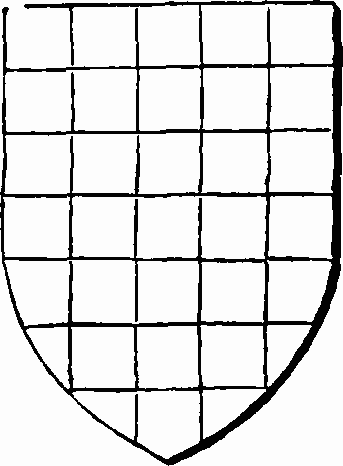
Arms: — Checky, Or, and Gules.
It has been already stated, that the Dalstons, extinct in 1765, were descended from a younger son of Hubert de Vallibus. The family of Vaux of Tryermain descended from another of his younger sons, became extinct in the reign of Edward IV.

Arms of Vaux of Tryermain: — Vert, a bend dexter, checky, O. and G.
The family of Vaux of Catterlen, descended from a younger branch of Vaux of Gilsland, possessed Catterlen as early as the reign of Henry II. John Vaux, Esq. the last of this family, who died about the middle of the seventeenth century, left two daughters, coheiresses, married to Richmond of High-head Castle, and Graham of Nunnery.
Arms of Vaux of Catterlen: — Or, a fesse checky, O. and G. between three garbs of the last.

The family of Vaux of Hayton, descended from Eustace de Vaux, contemporary of Hubert, the first Lord of Gilsland, are supposed to have taken the name of Castle-Carrock, and to have been extinct after four descents. The heiress married Denton.
There was a family of Vaux, supposed to have been descended from one of the younger branches of Vaux of Gilsland, who resided for many generations at Brownrigg, in the parish of Caldbeck. Robert Vaux, the last of this family, died in 1747, as appears by his tombstone in the church yard of that parish.
Windsor of Farlam. — An ancient family, which had not long been extinct in 1688 (fn. n24). They were probably a younger branch descended from Walter de Windsor, whose posterity, in the elder branch, being possessed of Farlam, by the gift of Ranulph de Meschines, took the name of Farlam, and became extinct temp Edw. III.

Arms: — Gules, a saltier, Arg. between twelve crosscrosslets, Or.
Families of whom it has not been ascertained whether they are or are not Extinct. (fn. n25)
Allison, described in the Heralds' visitations as having been settled for five generations at Yardsley-hall.

Arms: — Arg. a fesse G. between three black birds; a border of the second.
Ascough (fn. n26), described in St. George's visitation in 1615, as having been settled for six generations at Lacra, and for five at Abbey-Holme.
Bouche of Cockermouth. — Henry Bouche, aged 27, had an infant son living at the time of Dugdale's visitation, in 1665.

Arms: — Or, on a cross Sable, five escallop shells, Argent.
Crest: — A saracen's head.
Bresby of Penrith. — Thomas Bresby, the heir male, was 18 years of age at the time of Dugdale's visitation in 1665.

Arms: — Vaire, Arg. and Sab. a fesse, Gules.
Burrell of Howsell. — William Burrell, the representative of this family, was three years of age at the time of St. George's visitation in 1615.
Carliell, or Carlisle of Kirkbampton. — Originally, no doubt, of Carlisle. We have no account of this family having been extinct; but no certainty of its descent after the reign of Henry V. when Robert Carlisle represented the city of Carlisle in parliament, as his ancestors had frequently done. Families of this name and bearing the same arms, have been settled in Westmorland, Kent, and elsewhere.

Arms of Carlisle of Cumberland:—Or, a cross flory, Gules.
Chamber of Wolstey Castle, descended from a grandson of William Chamber of Holderness, and continued nine descents to 1615. Sir Thomas Chamber, of this family, purchased the manor of Hanworth in 1670; his son Thomas Chamber, Esq. who died in 1736, left two daughters, coheiresses, the elder of whom brought Hanworth to Lord Vere Beauclerk.
Arms:— Arg. a chevron, Az. between three trefoils, Gules.

Crest: — A boar passant, muzzled, lined and collared, Or.
Eglesfield of Alwardby. — An illegitimate branch of the ancient family of that name. Richard Eglesfield, the representative of this branch, was 23 years of age in 1665. They sold Allerby not many years afterwards.
Fairfax of Caldbeck. — A younger branch of Fairfax of Yorkshire. They seem to have been all extinct in 1665 except Robert, the eleventh son of Thomas Fairfax, who was then, of Cockermouth.

Arms: — Arg. three bars gemelles, G. over all a lion rampant, Sab. in the dexter chief a trefoil slipped, Azure.
Forster of Stanegarthside. — Nicholas Forster, the representative of this family, was 26 years of age at the time of Dugdale's visitation in 1665.

Arms:— Arg. on a chevron, Vert, between three bugles. Sab. stringed, Or. an escallop of the last.
Graham of Nunnery. — Descended from a younger branch of the Grahams, formerly of Rose-trees in Kirk-Andrews. George Graham, who sold Nunnery in 1690, had a son, but we cannot trace what became of him.
Arms:— The same as Graham of Netherby.
Highmore of Armathwaite.—Settled at that place in the reign of Henry IV. and probably at a much earlier period. The estate was sold by Mr. Benson Highmore in the last century.
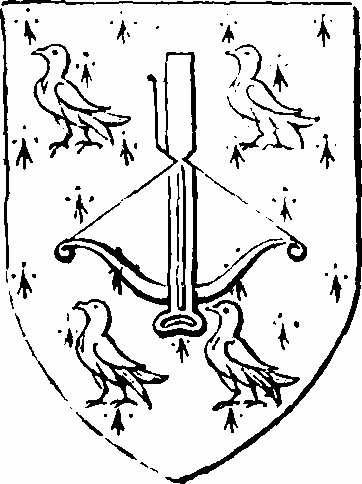
Arms: — Erm. a cross-bow bent, pointed downwards, between three moor-cocks, Sable.
Crest: — A moor-cock, Proper.
Hodgson of Bascodyke, several descents. — Peter Hodgson, aged 44, was the representative at the time of Dugdale's visitation in 1665. The pedigree was entered up by William Hodgson of the Six-Clerks office in 1729. His elder brother, (of the half blood,) then the representative of this family, is described as of Kingsfield and of Dormansted, in Cumberland. We have not been able to trace who is the present representative of this family. There are several of the name in the county.
Arms: — Party per chevron, engrailed, Or, and Az. three martlets counter-changed.
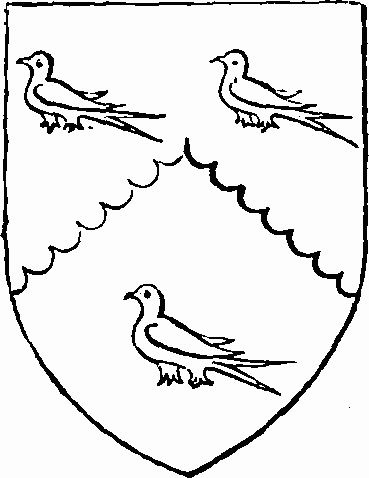
Crest: — A dove, Azure, winged, Or, membered and beaked, Gules, holding an olive branch.
Hutton of Hutton, traced to the reign of Edward I. Thomas Hutton, Esq. sold the manor of Hutton in 1605.
Langton of Heton. — A younger branch of the Langtons of Ledall, in Lancashire, settled in Cumberland in the reign of Queen Elizabeth.
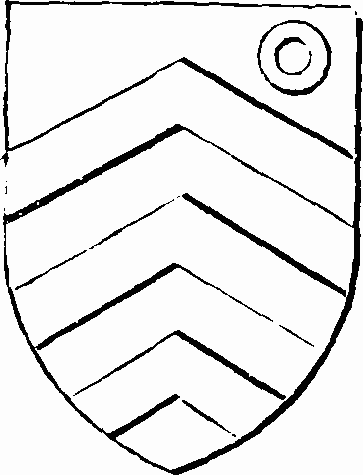
Arms: — Argent, three chevrons, Sable, in the dexter chief, an annulet for difference.
Martindale of Arcleby; returned among the gentry of Cumberland in the reign of Henry VI. married the heiresses of Newton and Arcleby.
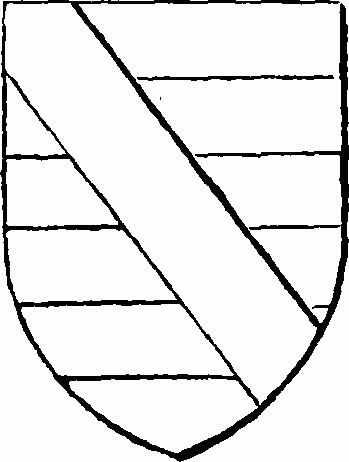
Arms: — Barry of six, Arg. and Gules, a bend, Sable.
Mulcaster or Muncaster.— A younger branch of the Peningtons of Muncaster. The Mulcasters were sheriffs of Cumberland in the reigns of Edward I. and III. and members for Carlisle in the reign of Richard II. and in that of Queen Elizabeth; one of this family married a coheiress of Tilliol. Richard Mulcaster, a native of Carlisle, was the first master of Merchant-Taylors' school, and afterwards upper master of St. Pauls.
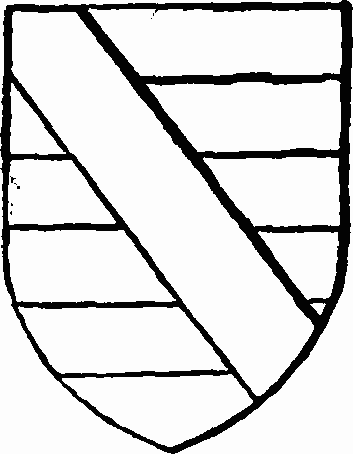
Arms:— Barry of six, Arg. and Gules, over all a bend, Azure.
Ogle of Thursby, from the reign of Edward II. to that of Edward IV. when the estate was sold.
Penruddock of Arcleby, originally no doubt of Penruddock in Greystock, settled at Arcleby in consequence of a grant from Queen Elizabeth. The Wiltshire Penruddocks were a branch of this family.
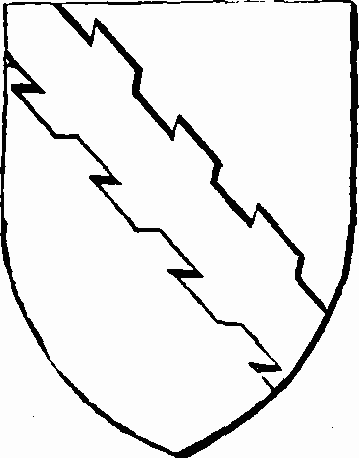
Arms:— Gules, a bend raguly, Argent.
Crest:— A demi-dragon, sans wings, rampant, Vert, between two eagle's wings expanded, Or.
Pickering of Threlkeld; married a coheiress of Threlkeld. The heiresses of Lascelles and Moresby married into this family.

Arms:— Erm. a lion rampant, Azure.
Rawling of Cockermouth; the son and heir of Henry Rawling, was 36 years of age at the time of Dugdale's visitation in 1665.
Ribton of Ribton, as early as the reign of Henry II. continued to be possessed of the manor as late as the reign of Henry VIII. probably extinct soon afterwards.

Arms:—Or, three crescents, Azure.
Simpson of Allerthwaite. — A branch of a Yorkshire family. Lancelot Simpson, of Fairbank, was aged 22 at the time of Dugdale's visitation.
Skelton of Armathwaite, Branthwaite, &c. — This ancient family, who represented the county in parliament as early as the reign of Edward I. were no doubt, originally of Skelton. Richard Skelton sold Armathwaite, which had so long been the seat of his ancestors, in 1712. An heiress of Colvill married into this family.
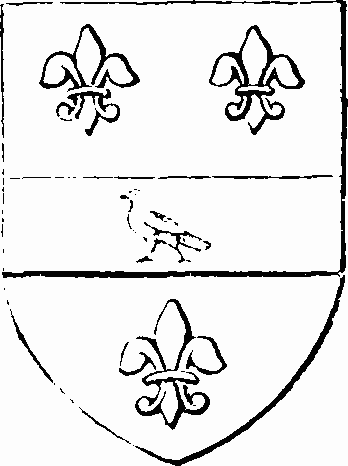
Arms of Skelton of Armathwaite:— Azure, on a fesse, Arg. between three fleurs delis, Or, a Cornish chough, Proper.
A younger branch of the Skeltons was of Branthwaite as early as the reign of Henry V. having married the heiress of Branthwaite. General Skelton, the last of the elder line of this branch, died in 1757.
The Skeltons of High-house were a younger branch of the Branthwaite family. This branch appears to have ended in female heirs in the reign of Charles II. Richard Skelton, who was 62 years of age at the time of Dugdale's visitation in 1665, had five daughters.
Thornborowe of Selsheyd; five descents are described in the visitation of 1530—not mentioned in subsequent visitations.

Arms:— Ermine, fretty, and a chief, Gules.
Thwaites, originally of Thwaites, afterwards of Unerigg-hall, which was sold about the beginning of the last century.
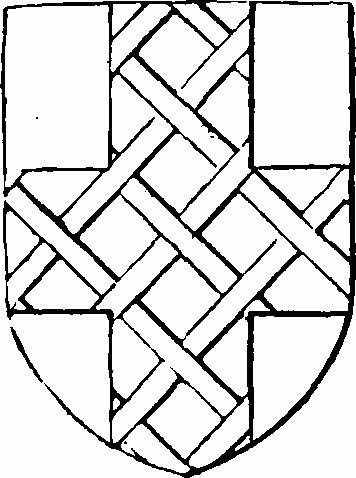
Arms:— Arg. a cross Sable, fretty, Or. (fn. n27)
Tolson of Woodhall, in Bride-kirk; settled there temp. Henry VIII. in consequence of a grant from the crown. An heiress of Saville married into this family.
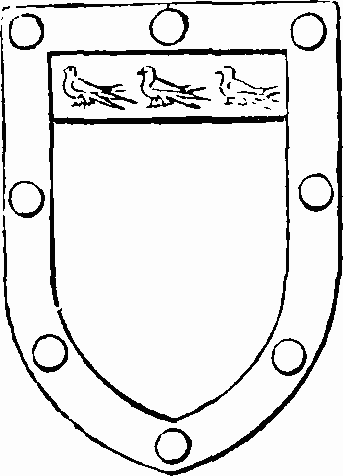
Arms:—Vert, on a chief Azure, three martlets, Or; a border, Or, charged with pellets.
Crest:—Out of a ducal coronet, Or, a lion's jamb, holding two ostrich feathers, one Vert, the other Azure.
Uriell of Cockermouth ; six descents. Richard Uriell, the representative of this family had male issue at the time of Dugdale's visitation in 1665.
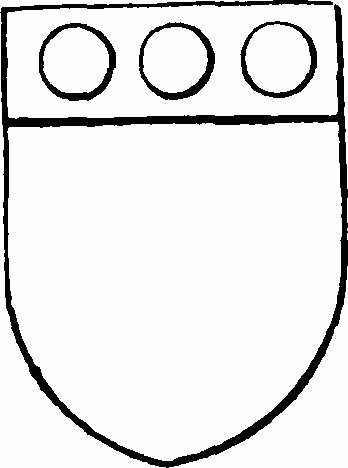
Arms: — Arg. on a chief Sable, three plates.
Wyvill of Johnby. — A younger branch of the Wyvills of ConstableBurton, in Yorkshire. Christopher Wyvill, of Johnby, was 28 years of age at the time of Dugdale's visitation in 1665.
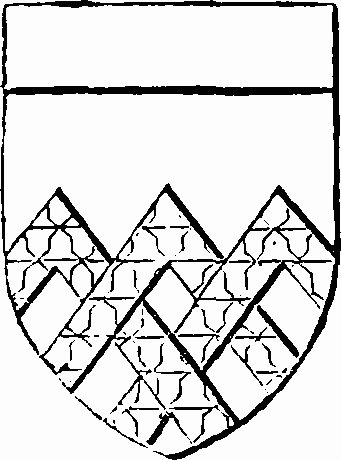
Arms:—Gules, three chevrons in base, interlaced, Vaire; a chief, Or.